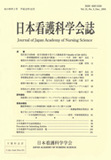Japanese
English
- 販売していません
- Abstract 文献概要
- 参考文献 Reference
要旨
本研究の目的は,気管内吸引後に実施される「境界付腹臥位屈曲姿勢」と「ルティーンケア」とを比較し,その効果を行動状態(ストレスサインの出現および安定した睡眠状態)によって明らかにすることである.対象は9名の極低出生体重児であり,出生時の平均在胎週数は26.96週(23週6日~28週6日),平均出生体重は968.4g(572g~1524g)であった.
心拍数と動脈血酸素飽和度の測定による自律神経系と,行動観察による運動系の指標とを統合してストレスサインを,Thoman分類により睡眠状態を,吸引前から吸引後30分まで2分ごとに観察した.これにより,実験群は20観察場面,対照群は22観察場面のデータが得られた.
結果は,ストレスサインには,主効果である時間(F=3.530, p=0.0001)と介入の有無(F=12.476, p=0.01)に有意差が認められた.また,時間と介入の有無との間には,有意な交互作用が存在した(F=3.018, p=0.001).「境界付腹臥位屈曲姿勢」は,ストレスサインに対して,短時間に抑制的に働いたことが明らかになった.
気管内吸引終了から静的睡眠に入るまでの平均所要時間は,実験群が(11.5±7.2)分であったのに対して,対照群は(19.0±11.7)分であった.実験群は,対照群に比べて,有意に短い時間で静的睡眠に入った(t=-2.529, df=35, p=0.016).
以上のことから,「境界付腹臥位屈曲姿勢」は,ストレスサインを制限し,同時に自己調整行動を促進して睡眠に導き,落ち着いた状態を維持させるのに効果があったことが明らかになった.
Abstract
The purpose of this study is to determine differences in behavioral (stress signs and sleep-wake state) responses following endotracheal suction in very low birth weight infants between routine care and flexed posture with boundaries.
The nine infants in this study had a mean gestational age of 26.96 weeks (ranging for 23 weeks and 6 days to 28 weeks and 6 days) and a mean birth weight of 968.4 grams (ranging for 572 to 1,524 grams).
Heart rate and arterial oxygen saturation were monitored for estimating autonomic functions, while the motor system parameters were measured visually through observations. The autonomic and motor system variables were integrated and used to trace stress signs. States of sleep were assessed according to the Thoman classification. Observations were made every 2 minutes for 30 minutes, beginning at the baseline and finishing 30 minutes after the end of suctioning.
A total of 42 sessions were recorded, among which 20 were for the experimental and 22 were for the control group. Two groups did not differ significantly in birth weight and gestational age at birth.
The results of two-way repeated measures (ANOVA) for each variable indicated that the groups differed significantly in stress signs. There were significant differences in effects of time (F=3.530, p=0.0001), intervention (F=12.476, p=0.01)and intervention-by-time interaction for stress signs (F=3.018, p=0.001). In the experimental group exhibited fewer stress signs than in the control group.
The time before onset a quiet sleep state differed significantly between the groups (t=-2.529, df=35, p=0.016). In the experimental group was significantly shorter time than in the control group.
The flexed posture in the prone position with boundaries around the infant's body are needed to help the very low birth weight infants enhance self-regulatory behavior to maintain a behavioral integrity.
Copyright © 2001, Japan Academy of Nursing Science. All rights reserved.


